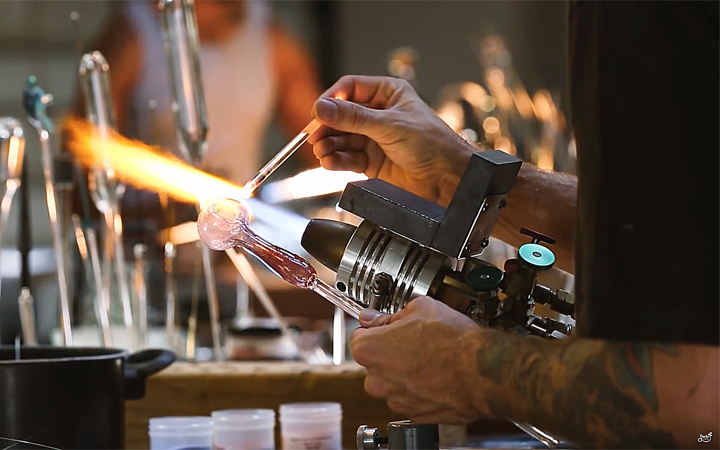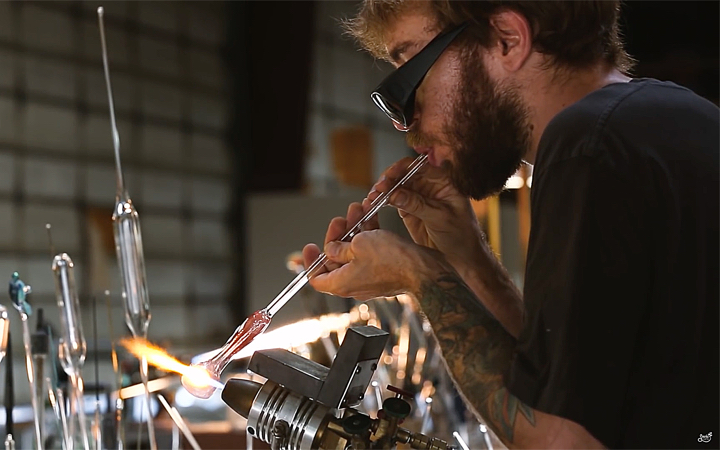This article is sponsored by Smoke Cartel, an online retailer and head shop made up of a close-knit team of glass lovers dedicated to making sure you get the best possible smoking gear.
The American glass industry is huge, and behind every American-made glass piece is an artist who spent countless hours in front of a scorching-hot torch, harnessing inspiration day in and day out to create something beautiful. There are thousands of glassblowers around the country, forging everything from streamlined spoon pipes to intricately decorated one-of-a-kind headies as you read this. We set out to draw attention to the hard workers behind the flame who make our favorite hobby feasible.
How are Cannabis Glass Hand Pipes Made?

It takes an insane amount of knowledge, experience, and practice to create flawless glass art with your hands. When you hold a handcrafted dry pipe, you don’t see the hundreds of pipes the artist cracked to get to that point, the colors that were overheated and boiled, or the pipes that didn’t function or weren’t perfectly shaped. Picking up a handmade spoon means you’re holding the epitome of that glassblower’s craftsmanship. Nothing less leaves the studio.
When first starting out on the torch, glassblowers typically begin with hand pipes. Cannabis hand pipes – also known as glass bowls – are a phenomenal way for artists to get their chops down before moving on to more complicated pieces. The streamlined design of hand pipes makes them a bit easier to create than highly functional water pipes, because these dry pipes don’t have elaborate percs and filtration systems like bongs and dab rigs do.
To create them, glass artists begin by taking a long glass tube and breaking it down into sections about four inches long. The artist then decorates each section, choosing from a variety of techniques depending on the specific look they’re going for. Fuming, dichro, striping, wrap and rakes, caning, latticino, latticello, reticello, or the use of millefiore or murrine techniques (to name just a few) can be as simple or as complex as the artist desires and is capable of.
From there, the artist begins to create the shape of the pipe by heating and then stretching the neck. After the neck stretch, they shape out the mouthpiece before moving on to the bowl. Glassblowers carefully shape the bowl by blowing into the end of the tube and working the glass in a circular motion in front of the flame to make sure the shape is even and consistent. Next, the artist adds any accents or grips along the side of the pipe before doing their bowl push and popping the carb.
The last step is to press the hot pipe onto a plate to flatten the bottom. Finally, glass artists either place the bowl in the kiln or break it clean from the handle to let it cool.
The following video shows the stunning process in full:
Why Purchase a Hand Pipe by Your Favorite Glass Artist?

Hand pipes are arguably the most commonly used glass pieces, and even though there are fewer variables in constructing a hand pipe than in a water pipe, making them still requires a large amount of training and experience that you can’t acquire by simply reading a book or taking a crash course. As Aaron Galloway of Burner Glassworks puts it, “Glass is not a really easy medium to work in. It’s hot, it can burn you, it breaks and can cut you. It takes a long time to figure out how to make it do what you want it to do.”
That sort of familiarity is only earned by spending time on the torch and perfecting an array of glassblowing techniques, so the hand pipes that result from this level of experience are not only a classic and effective method of smoking, they’re a wonderful way to show off your favorite artist’s work.
If you own a dispensary, headshop, or smoke shop, and are interested in purchasing wholesale glass pipes, bongs, accessories, and more, check out Glassheads Distribution.


